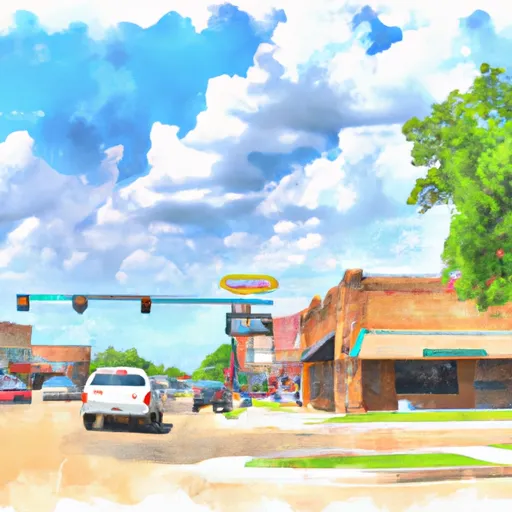-
 Snoflo Premium
Snoflo Premium
Get unlimited access to all our content
With no Ad interruptions! - Start Your Free Trial Login with existing account
Colbert
Eden Index
Climate
9.8
•
Recreation
5.7
•
Community
1.8
•
Safeguard
6.4/10

Colbert, Oklahoma is a small town located in Bryan County. The climate in this area is characterized by hot summers and mild winters, with an average annual temperature of around 62°F. The town is situated near the Blue River, which provides a source of water for the area. However, the river has been impacted by pollution from agricultural and industrial activities, leading to concerns about water quality. Despite these challenges, there are still outdoor recreation opportunities in the area, such as fishing and kayaking on the Blue River, as well as hiking and camping in nearby state parks. Overall, Colbert offers a peaceful rural setting for those who enjoy outdoor activities.
What is the Eden Index?
The Snoflo Eden Index serves as a comprehensive rating system for regions, evaluating their desirability through a holistic assessment of climate health, outdoor recreation opportunities, and natural disaster risk, acknowledging the profound impact of these factors on livability and well-being.
Climate Health Indicator (CHI): 9.8
Colbert receives approximately
1046mm of rain per year,
with humidity levels near 75%
and air temperatures averaging around
17°C.
Colbert has a plant hardyness factor of
7, meaning
plants and agriculture in this region tend to thrive during the non-winter months.
By considering the ideal temperature range, reliable water supplies, clean air, and stable seasonal rain or snowpacks, the Climate Health Indicator (CHI) underscores the significance of a healthy climate as the foundation for quality living.
A healthy climate is paramount for ensuring a high quality of life and livability in a region, fostering both physical well-being and environmental harmony. This can be characterized by ideal temperatures, reliable access to water supplies, clean air, and consistent seasonal rain or snowpacks.
Weather Forecast
Streamflow Conditions
Red-Little
Area Rivers
Red-Little
Snowpack Depths
Red-Little
Reservoir Storage Capacity
Red-Little
Groundwater Levels
Recreational Opportunity Index (ROI): 5.7
The Recreational Opportunity Index (ROI) recognizes the value of outdoor recreational options, such as parks, hiking trails, camping sites, and fishing spots, while acknowledging that climate plays a pivotal role in ensuring the comfort and consistency of these experiences.
Access to outdoor recreational opportunities, encompassing activities such as parks, hiking, camping, and fishing, is crucial for overall well-being, and the climate plays a pivotal role in enabling and enhancing these experiences, ensuring that individuals can engage in nature-based activities comfortably and consistently.
Camping Areas
| Campground | Campsites | Reservations | Toilets | Showers | Elevation |
|---|---|---|---|---|---|
| Oak Park - Navarro Mills Reservoir | 50 | 465 ft | |||
| Liberty Hill - Navarro Mills Reservoir | 110 | 467 ft | |||
| Mott - Bardwell Lake | 40 | 463 ft | |||
| Caney Creek - Lake Texoma | None | 646 ft | |||
| Lighthouse Resort | None | 673 ft | |||
| Dam Site | None | 560 ft | |||
| East Burns Run - Lake Texoma | None | 661 ft | |||
| Highview - Bardwell Lake | 40 | 432 ft | |||
| Erwin Park - McKinney | None | 637 ft | |||
| Waxahachie - Bardwell Lake | 70 | 469 ft |
Nearby Fishing
Catastrophe Safeguard Index (CSI):
The Catastrophe Safeguard Index (CSI) recognizes that natural disaster risk, encompassing floods, fires, hurricanes, and tornadoes, can drastically affect safety and the overall appeal of an area.
The level of natural disaster risk in a region significantly affects safety and the overall livability, with climate change amplifying these risks by potentially increasing the frequency and intensity of events like floods, fires, hurricanes, and tornadoes, thereby posing substantial challenges to community resilience and well-being.
Community Resilience Indicator (CRI): 1.8
The Community Resilience Indicator (CRI) recognizes that education, healthcare, and socioeconomics are crucial to the well-being of a region. The CRI acknowledges the profound impact of these elements on residents' overall quality of life. By evaluating educational resources, healthcare accessibility, and economic inclusivity, the index captures the essential aspects that contribute to a thriving community, fostering resident satisfaction, equity, and social cohesion.

